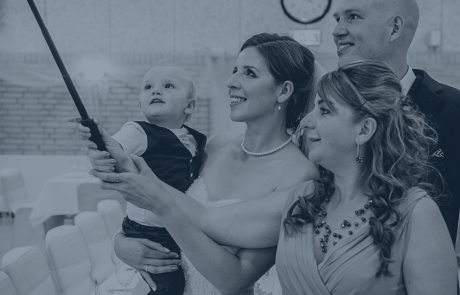How Facebook Audience Insights Can Inform Campaign Planning
Matt Bell-Watson • 11 May 2020
Mark Zuckerberg is sitting on a vast mountain of data. Every day, some 1.73 billion people use Facebook. This number is even higher across Facebook, Messenger, WhatsApp and Instagram. The latest earnings report puts the total daily userbase at 2.36 billion, as of the end of March 2020.
Facebook launched Audience Insights in 2014 to help brands use some of this data. The tool provides free access to anonymised data about three groups of people. You can look at all people on Facebook, people that have liked your brand’s page, or create a custom audience.
Of course, the Audience Insights tool aims to help brands advertise on Facebook. But it’s also very useful for other purposes. It can help with researching content, planning campaigns or creating personas.
The Thinking Brand’s Guide to Using Audience Insights
Pinpoint Your Audience
Let’s say you’re launching a new app for planning weddings. It’s important to define who your target audience is. Desk research is a good starting point and you can find out a lot in a few minutes.
A quick search shows that the average age for heterosexual marriage is 35.7 years for women and 38 years for men. For same-sex couples, it’s a little older. The average is 36.6 years for women and 40.1 years for men, according to the Office for National Statistics. While the average engagement lasts almost two years.
A few data points like this gives you a good steer to target your audience. You can make this even more detailed by defining other attributes. And look at your existing audience – those people that have liked your brand page. In this case, let’s look at women aged 30 – 40, that live in the UK and got engaged in the last 12 months.
Expand Your Knowledge
Now that you have defined your audience, you can start to take a deeper look at them. This is a good opportunity to test any assumptions and revise your audience sample. You might find that your target audience is older than you expected or more likely to be male than female.
In this case, we can see that there are around 35-40,000 people that meet our criteria. This estimate may change over time as it’s based on ad data from Facebook apps and services from the past 30 days.
We can also see that 64% of women in our sample are 30-34 years old. We know that this is a little younger than the average age of marriage. But this makes sense, as we also know that many people wait a couple of years before tying the knot.
Audience Insights offers data on relationship status and education level. In this case, as we’re looking at women who got engaged in the past 12 months, most of our audience fits into this category.
Education level is more interesting. We can see that this audience is 10% more likely to be university educated than the average person. And 38% more likely to have studied as postgraduate level. This can be useful when considering the readability of campaign content.
And finally, we can explore what sectors the audience is likely to work in. We can see that our audience is 50% more likely than the average person to work in community and social services. And 67% less likely to work in architecture and engineering. But most likely to work in administrative services. This is a useful insight for buyer personas and planning integrated campaigns.
Inform Campaign Targeting
As we click through the tabs, we can look at more demographic data on location, as well as behaviour. It can be helpful to find out what your target audience does on social media and how they get online. This can inform things like influencer activity, campaign landing pages, and campaign targeting.
In the case of our recently engaged women, it’s clear that wedding planning is well underway. This target audience is 680 times more likely to like the UK Bride’s Facebook page than the average person. While we can also see that around 8,100 people that fit our criteria like Want That Trend. This might be a good brand to investigate further to identify best practice.
Facebook sorts many of the pages liked by this audience into Top Categories. These include lifestyle indicators like Film and TV, media consumption, brands and hobbies.
In the case of our audience, many interests refer to families, kids and parenting. This insight could inform campaign content and creative. For instance, you may want to use more images of happy couples with children in campaigns. A blog post about fun ways to include your kids in your wedding may also interest this audience.
In the last tab, Facebook provides data on online activity and devices. This can give you more of a sense of how your target audience uses social media and accesses the web. It’s interesting to see that our target audience is almost twice as likely to click on ads than the average person. And is more than 10 percentage points more likely to only use a mobile device to access Facebook.
And finally, you can save your audience for future use. A custom audience makes targeting future campaigns easy. But you’re likely to want to segment your audience further. For instance, brides with children or those with same-sex partners. Not all brides to be will respond to campaign messaging, creative or content in the same way.
How Facebook Audience Insights Can Inform Campaign Planning
Matt Bell-Watson • 11 May 2020
Mark Zuckerberg is sitting on a vast mountain of data. Every day, some 1.73 billion people use Facebook. This number is even higher across Facebook, Messenger, WhatsApp and Instagram. The latest earnings report puts the total daily userbase at 2.36 billion, as of the end of March 2020.
Facebook launched Audience Insights in 2014 to help brands use some of this data. The tool provides free access to anonymised data about three groups of people. You can look at all people on Facebook, people that have liked your brand’s page, or create a custom audience.
Of course, the Audience Insights tool aims to help brands advertise on Facebook. But it’s also very useful for other purposes. It can help with researching content, planning campaigns or creating personas.
The Thinking Brand’s Guide to Using Audience Insights
Pinpoint Your Audience
Let’s say you’re launching a new app for planning weddings. It’s important to define who your target audience is. Desk research is a good starting point and you can find out a lot in a few minutes.
A quick search shows that the average age for heterosexual marriage is 35.7 years for women and 38 years for men. For same-sex couples, it’s a little older. The average is 36.6 years for women and 40.1 years for men, according to the Office for National Statistics. While the average engagement lasts almost two years.
A few data points like this gives you a good steer to target your audience. You can make this even more detailed by defining other attributes. And look at your existing audience – those people that have liked your brand page. In this case, let’s look at women aged 30 – 40, that live in the UK and got engaged in the last 12 months.
Expand Your Knowledge
Now that you have defined your audience, you can start to take a deeper look at them. This is a good opportunity to test any assumptions and revise your audience sample. You might find that your target audience is older than you expected or more likely to be male than female.
In this case, we can see that there are around 35-40,000 people that meet our criteria. This estimate may change over time as it’s based on ad data from Facebook apps and services from the past 30 days.
We can also see that 64% of women in our sample are 30-34 years old. We know that this is a little younger than the average age of marriage. But this makes sense, as we also know that many people wait a couple of years before tying the knot.
Audience Insights offers data on relationship status and education level. In this case, as we’re looking at women who got engaged in the past 12 months, most of our audience fits into this category.
Education level is more interesting. We can see that this audience is 10% more likely to be university educated than the average person. And 38% more likely to have studied as postgraduate level. This can be useful when considering the readability of campaign content.
And finally, we can explore what sectors the audience is likely to work in. We can see that our audience is 50% more likely than the average person to work in community and social services. And 67% less likely to work in architecture and engineering. But most likely to work in administrative services. This is a useful insight for buyer personas and planning integrated campaigns.
Inform Campaign Targeting
As we click through the tabs, we can look at more demographic data on location, as well as behaviour. It can be helpful to find out what your target audience does on social media and how they get online. This can inform things like influencer activity, campaign landing pages, and campaign targeting.
In the case of our recently engaged women, it’s clear that wedding planning is well underway. This target audience is 680 times more likely to like the UK Bride’s Facebook page than the average person. While we can also see that around 8,100 people that fit our criteria like Want That Trend. This might be a good brand to investigate further to identify best practice.
Facebook sorts many of the pages liked by this audience into Top Categories. These include lifestyle indicators like Film and TV, media consumption, brands and hobbies.
In the case of our audience, many interests refer to families, kids and parenting. This insight could inform campaign content and creative. For instance, you may want to use more images of happy couples with children in campaigns. A blog post about fun ways to include your kids in your wedding may also interest this audience.
In the last tab, Facebook provides data on online activity and devices. This can give you more of a sense of how your target audience uses social media and accesses the web. It’s interesting to see that our target audience is almost twice as likely to click on ads than the average person. And is more than 10 percentage points more likely to only use a mobile device to access Facebook.
And finally, you can save your audience for future use. A custom audience makes targeting future campaigns easy. But you’re likely to want to segment your audience further. For instance, brides with children or those with same-sex partners. Not all brides to be will respond to campaign messaging, creative or content in the same way.





Leave A Comment